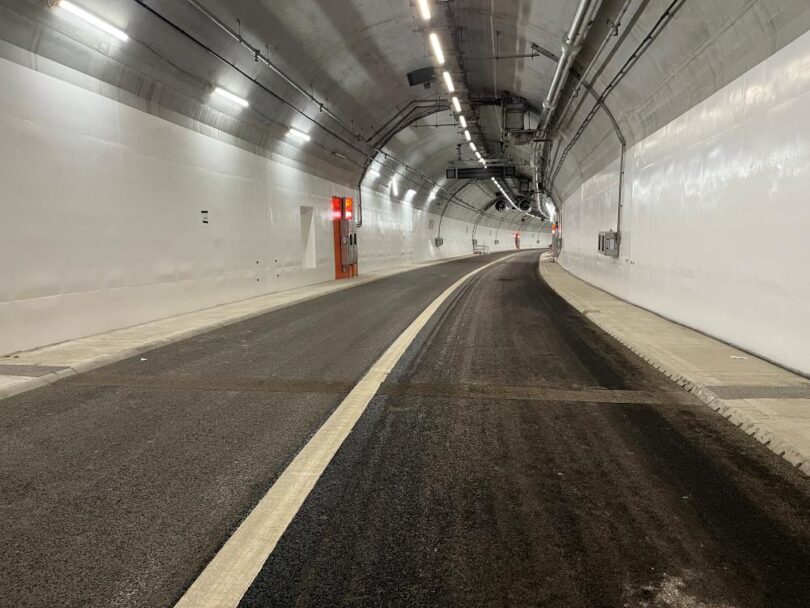Silvertown Tunnel, which runs beneath the Thames, opened for use on 7 April 2025. Its main purpose is to ease congestion in Central London and lower journey times by up to 20 minutes. Commissioned as a Nationally Significant Infrastructure Project (NSIP), ACO Technologies played a vital role in the tunnel’s safety, crafting a bespoke solution to address both fire and flood risks.
In May 2018, Transport for London (TfL) was granted permission to build a new twin bore, 1.4km tunnel underneath the River Thames to link Silvertown to the Greenwich Peninsula. The project faced key challenges when it came to safety and protecting the tunnel’s users from potential hazards, notably the risks of sprinkler-induced flooding, and of vehicle fires spreading through the drainage system.
Brought on board early by principal engineering consultancy COWI, part of the Riverlinx construction joint venture, ACO applied the expertise of its Water Management and Building Drainage divisions to develop a unique kerb and drainage solution to mitigate these risks, featuring a dual-purpose pipe connection that functions as a flame trap.
Managing vehicle fires and flooding
ACO began by performing hydraulic analyses using its QuAD software, modelling flow rates over the tunnel’s gradients and geometry. This confirmed that the splayed KerbDrain SP480 units could manage the volume of water released by the sprinkler system.
Forming 2.8km of combined kerb drainage along one side of each tunnel, a total of 5,600 units of ACO’s KerbDrain SP480 were installed on the project, with KerbDrain Gully outlets every 15m. This system meets TfL’s specification of 50mm inlet diameters or less, while preventing blockages from debris.
Not fuelling the fire
Beyond effective drainage, ACO’s KerbDrain system also features a bespoke flame trap system. To reduce the dangers involved with fuel spills entering the tunnel’s drainage network and subsequently alighting and spreading, ACO engineered a u-bend between the KerbDrain Gullies and the carrier pipe. This ensures that the pipes are always partially filled with water, which means fire is prevented from spreading through the downstream network.
The flame trap itself is constructed from stainless-steel components by ACO Building Drainage and uses a custom spigot to join 170mm ductile iron pipes with 160mm stainless-steel pipes.
Accounting for expansion
By April 2024, with many KerbDrain units already installed, it became apparent that expansion joints were necessary at tunnel interfaces to accommodate movement without disrupting drainage. ACO was tasked with designing an accessory to link the SP480 units while allowing for this movement.
Faced with a tight two month deadline, ACO’s research and development team designed and tested a new channel expansion joint capable of accommodating 20mm of horizontal and 16mm of vertical movement, all while withstanding the force of a ten tonne lorry.
The end product was a robust stainless-steel unit anchored on each side of the KerbDrain SP480s. It features ribbed reinforcement and has been rigorously tested to EN1433 standards, including a 10 tonne accidental wheel loading test in accordance with the design manual for roads and bridges (DMRB) specifications and EN1433 Load Class D400. Additionally, ACO specified two flexible 100mm polypropylene pipes, positioned behind the stainless-steel cover, to ensure water is carried across the joint effectively.
Tunnel vision for safety
Mathais Hansen of COWI said: “We recognised the need for ACO’s specialist expertise, given their proven track record with projects like the Hindhead Tunnel in Surrey and their strong reputation for tunnel projects in Germany.
“Tunnel vehicle fires, which risk trapping people and hindering emergency response, necessitate controlled fire suppression despite associated flooding risks. ACO’s solution expertly mitigates both hazards while complying with specifications.”
Mikel Goirigolzarri Martinez, Project Manager for Riverlinx, said: “Having ACO on this project has really shown why they are leaders in the field of drainage and water management. The speed ACO turned around the design, testing, production, and delivery of the channel expansion joints was highly impressive, and meant we could keep the timeline on track. We were incredibly grateful to the team for providing guidance on how to install the units and going above and beyond to ensure the job went smoothly.”
Terry Wilkinson, Specialist Design & Application Engineer at ACO, said: “It isn’t every day that you get to work on a project with such significance as Silvertown Tunnel and we’re proud to have our solutions specified. By combining all of our experience across our divisions and working meticulously with Riverlinx, we’ve come up with a drainage system that satisfied all the necessary requirements from TfL and make the tunnel safer for users and the tunnel infrastructure itself.”








